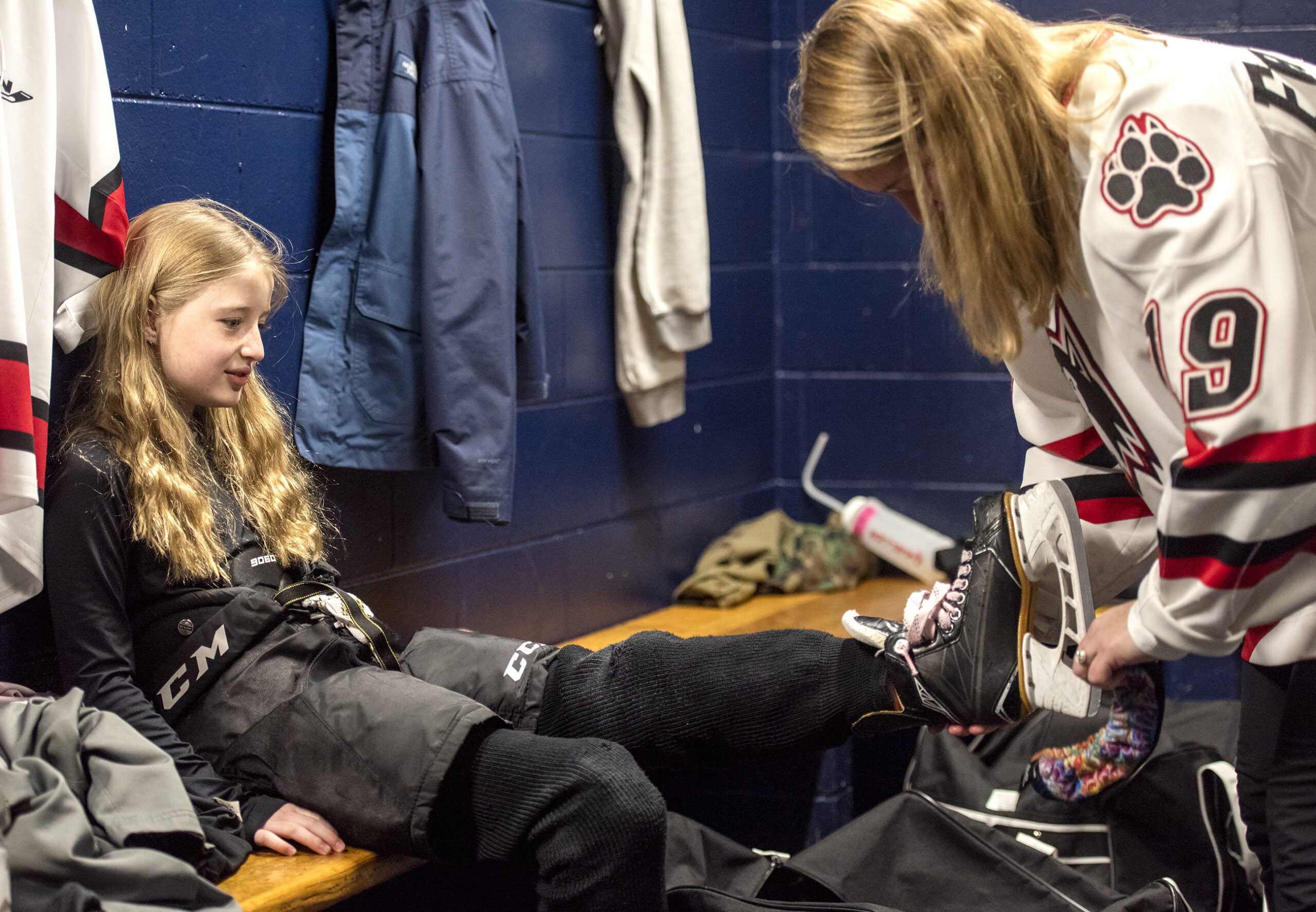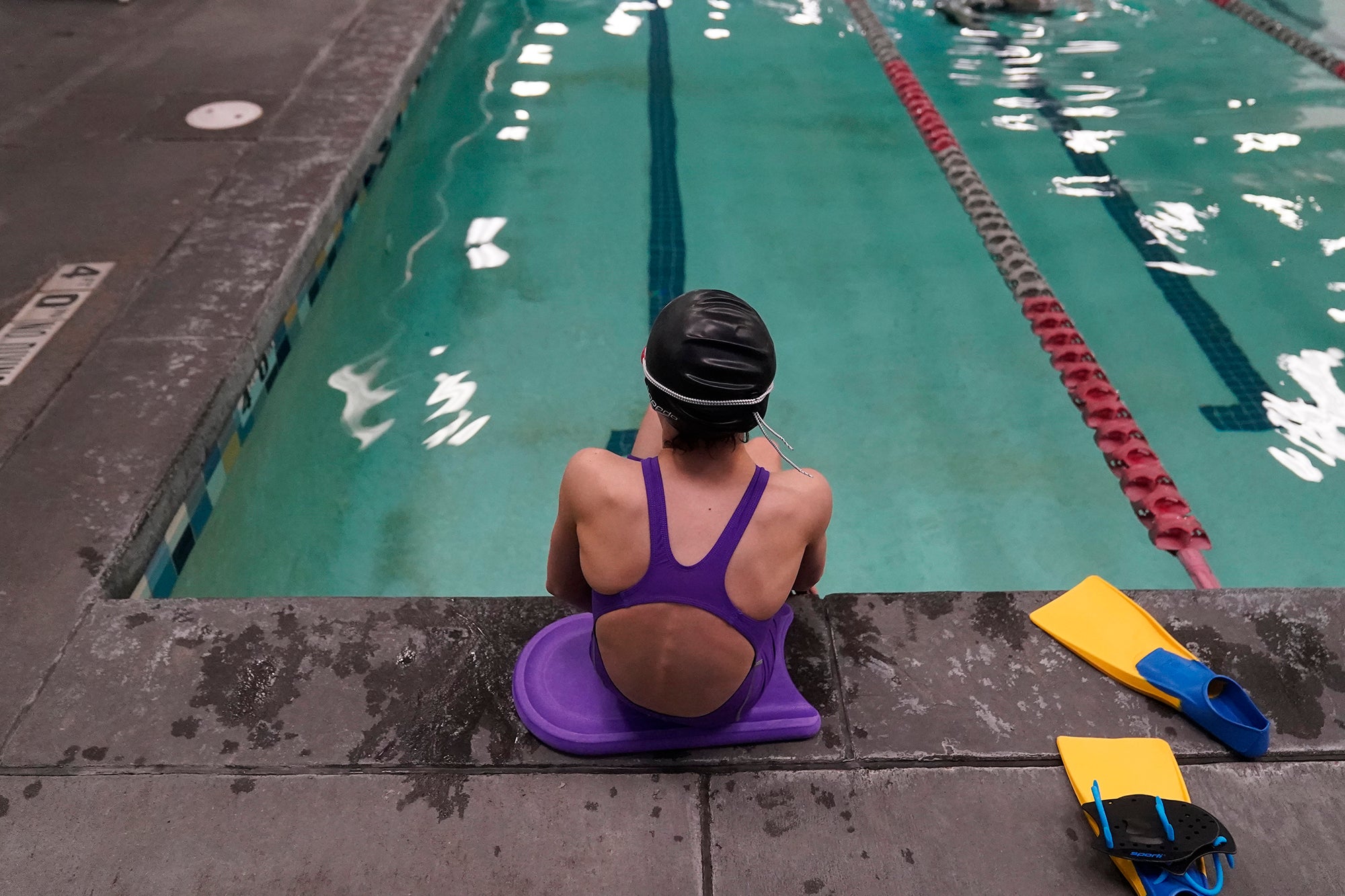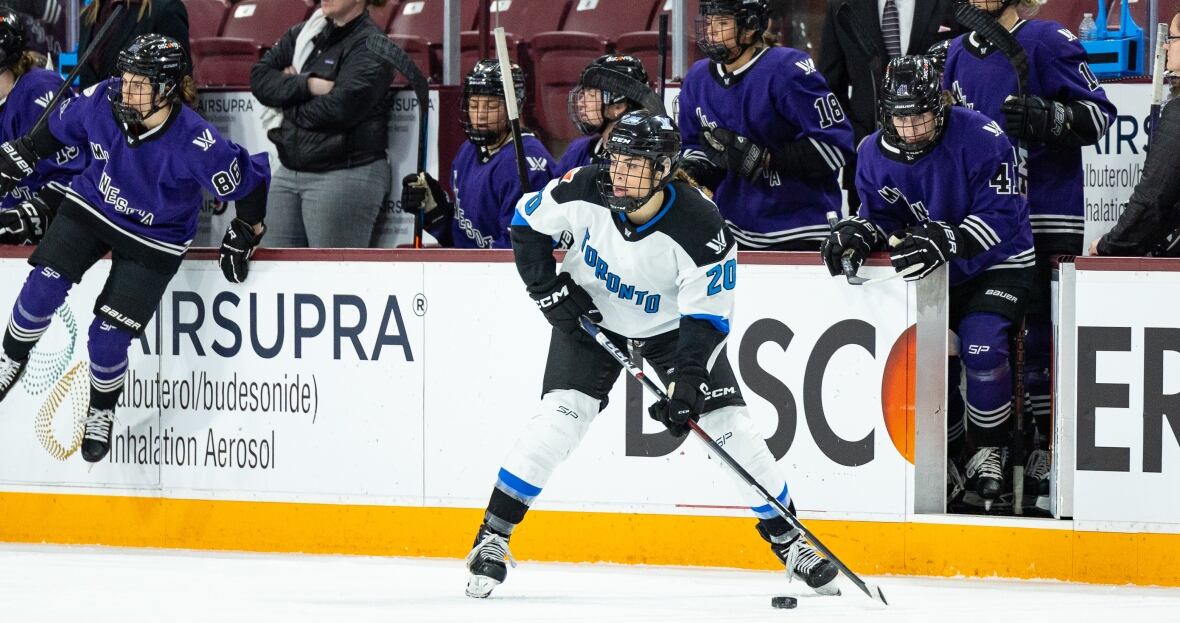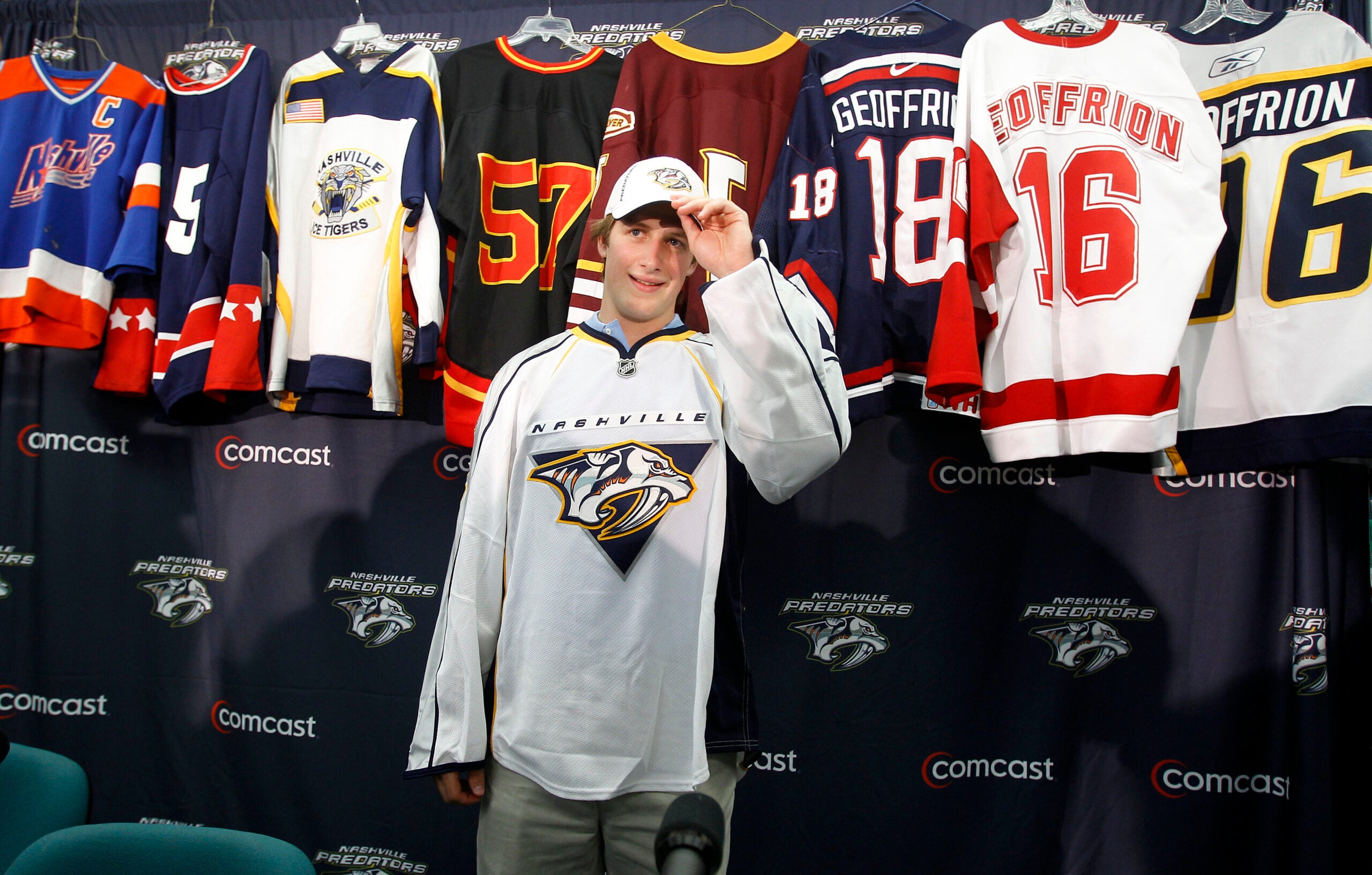When women’s ice hockey was added to the Olympic Games in 1998, Alex Cavallini (then Rigsby) was 6 years old and just learning how to skate. But as she watched players like Cammi Granato and Angela Ruggiero win gold, she told her mom she was certain of one thing.
“She goes, ‘I’m going to go to the Olympics someday,’” Nancy Rigsby said.
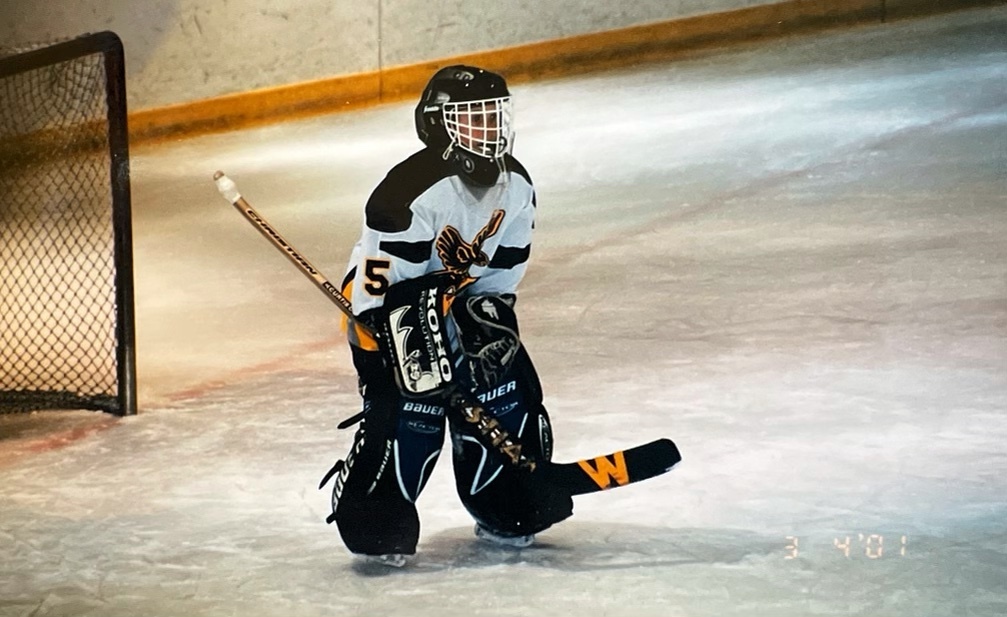
Stay informed on the latest news
Sign up for WPR’s email newsletter.
Twenty years later, she made good on that promise as the backup goaltender for gold-medal Team USA at the 2018 Games in Pyeongchang — and again as part of this year’s team in Beijing. The U.S. women took silver Wednesday night, falling to long-standing rival Canada in a hard-fought final game. But their success over the years is already sparking change in girls hockey and inspiring the next generation of players.
And Cavallini’s path to the apex of women’s ice hockey was not an easy one.
“Her story is a little different because there weren’t as many quality girls clubs as there are now,” Rigsby said. “So, she never played girls hockey really other than a few tournament teams until she went to college.”
[[{“fid”:”1664396″,”view_mode”:”embed_landscape”,”fields”:{“format”:”embed_landscape”,”alignment”:”right”,”field_image_caption[und][0][value]”:”%3Cp%3EA%20six-year-old%20Alex%20Cavallini%20sits%20in%20the%20locker%20room%20surrounded%20by%20hockey%20gear.%20Now%2030%2C%26nbsp%3BCavallini%20is%26nbsp%3Ba%20goalie%20for%20U.S.%20women’s%20hockey%20team%20competing%20in%20the%20Beijing%20Winter%20Olympics.%26nbsp%3B%3Cem%3EPhoto%20courtesy%20of%20Nancy%20Rigsby%3C%2Fem%3E%3C%2Fp%3E%0A”,”field_image_caption[und][0][format]”:”full_html”,”field_file_image_alt_text[und][0][value]”:”A six-year-old Alex Cavallini sits in the locker room surrounded by hockey gear. “,”field_file_image_title_text[und][0][value]”:”A six-year-old Alex Cavallini sits in the locker room surrounded by hockey gear. “},”type”:”media”,”field_deltas”:{“2”:{“format”:”embed_landscape”,”alignment”:”right”,”field_image_caption[und][0][value]”:”%3Cp%3EA%20six-year-old%20Alex%20Cavallini%20sits%20in%20the%20locker%20room%20surrounded%20by%20hockey%20gear.%20Now%2030%2C%26nbsp%3BCavallini%20is%26nbsp%3Ba%20goalie%20for%20U.S.%20women’s%20hockey%20team%20competing%20in%20the%20Beijing%20Winter%20Olympics.%26nbsp%3B%3Cem%3EPhoto%20courtesy%20of%20Nancy%20Rigsby%3C%2Fem%3E%3C%2Fp%3E%0A”,”field_image_caption[und][0][format]”:”full_html”,”field_file_image_alt_text[und][0][value]”:”A six-year-old Alex Cavallini sits in the locker room surrounded by hockey gear. “,”field_file_image_title_text[und][0][value]”:”A six-year-old Alex Cavallini sits in the locker room surrounded by hockey gear. “}},”link_text”:false,”attributes”:{“alt”:”A six-year-old Alex Cavallini sits in the locker room surrounded by hockey gear. “,”title”:”A six-year-old Alex Cavallini sits in the locker room surrounded by hockey gear. “,”class”:”media-element file-embed-landscape media-wysiwyg-align-right”,”data-delta”:”2″}}]]Instead, Cavallini and many of her teammates grew up playing boys hockey, often as the only girl on their teams. They dressed alone in bathrooms instead of locker rooms and constantly elbowed for space in a sport that has not always been welcoming to girls.
In the more than two decades since that first Olympic gold, girls ice hockey has seen a surge in popularity.
In 2002, Wisconsin’s high school sports association, WIAA, started its first girls hockey program. Since then, it has grown from six to 28 teams with more than 800 players. And although this is still only a third the size of the 86-team boys program, WIAA assistant director Tom Shafranski said he has seen significant changes in players’ demographics.
“Most of them were in hockey families — their brothers, their dads were participants. And now we’re starting to see where moms are able to say, ‘Hey, you know, I played for this team, and it was a great thing for me,’ and their daughters are the ones who are now coming forward,” Shafranski said.
He added: “And we certainly see an uptick whenever the Olympics come around and the girls Olympic program does well, especially when they win gold.”
Now, as the 50th anniversary of Title IX approaches and the Beijing Olympics is lauded as the most gender-balanced Winter Games, leaders in girls and women’s hockey are still trying to smooth the ice for the next generation of players.
Making room at the top
The Ferwerdas are not your typical hockey family. For starters, they’re mostly women.
Judy Ferwerda grew up playing pond hockey in her family’s backyard in Oregon.
“There’s 10 in my family, so we basically had a team of hockey players,” Ferwerda said.
Both her daughters played hockey, and now she watches her granddaughters play the sport she loves. Last year, Ferwerda was the third woman to be inducted into the Wisconsin Hockey Hall of Fame. She left her mark on the sport as a coach and advocate for girls hockey.
Ferwerda’s daughters, Jessica Martin and Amanda Ferwerda, both played boys hockey in the ’80s. And they were good. By ages 11 or 12, they were skating circles around other players and had their sights set on playing college hockey.
But Ferwerda struggled to find opportunities for Jessica and Amanda to play with other girls of their caliber. Around that age, checking starts to become part of the boys game, and many girls quit the sport. Without the chance to play at a higher level, the likelihood of being seen by a college women’s hockey recruiter was slim.
So Ferwerda and her husband, Dave, started their own team — the Wisconsin Challengers — and rounded up the strongest female players they could find to fill the roster.
“I had an 8-year-old, an 18-year-old, and I had nine players on my team and a goalie. We started a team and away we went,” Ferwerda said.
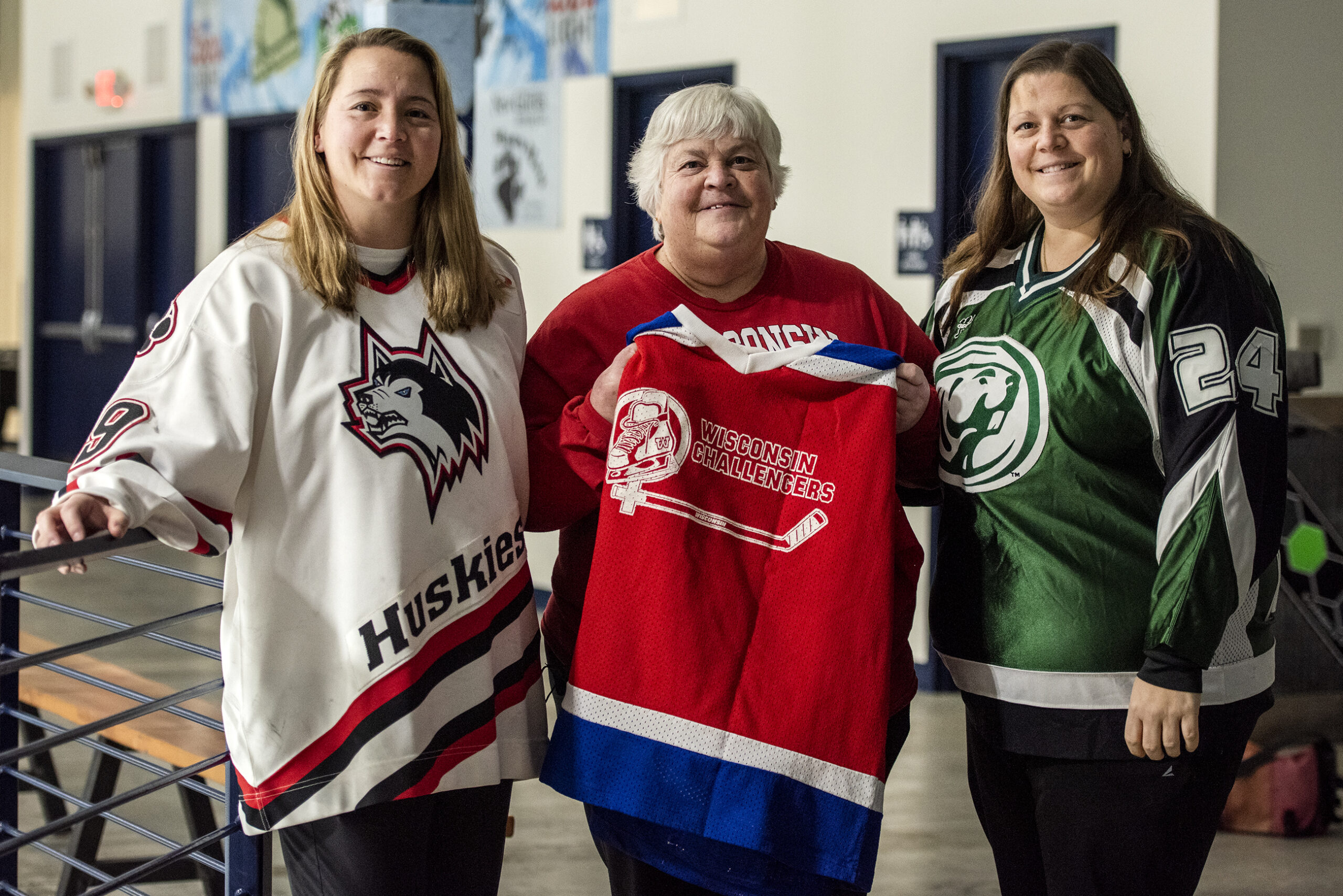
As the very first Tier 1 girls team in the state, the Challengers became a critical pipeline to elite-level play. Both Ferwerda’s daughters went on to play college hockey — Jessica at Northeastern University and Amanda at Bemidji State University — and the Challengers, later absorbed by the Madison Capitols, would eventually produce Olympians like Amanda Kessel, Brianna Decker and Cavallini.
And two decades later, efforts by Ferwerda and other advocates are still trickling upward.
This season, the NCAA expanded the Division I women’s hockey championship brackets from eight to 11 teams and added several new Division III programs.
“Each team, that’s 25 additional roster spots. So there’s more room at the top,” said Carla Pentimone, who played for the University of Wisconsin-Madison from 2009-11. Now she’s the owner and founder of Women’s College Hockey Recruiting, helping more than 250 young women navigate the transition to elite-level hockey.
“I have young girls who want to play hockey at Wisconsin or Minnesota, and they wear those sweatshirts. And I think being able to look at those teams that have had so much success and see what can be — the beautiful locker rooms and the amenities and even taking jets to play teams — as females, it’s just, it’s so cool,” Pentimone said.
At the professional level, women’s hockey has gotten more attention in recent years. After player boycotts during the 2019-21 season over low wages and lack of benefits, Premier Hockey Federation, the women’s professional league, announced last month it will raise salary caps and add four new teams.
Granato, the former Olympian and Hall-of-Famer, was recently hired as the assistant general manager for the NHL’s Vancouver Canucks after serving as the league’s first female scout. And for the first time ever, the gaming company EA Sports added women’s teams to the 2022 version of their popular NHL video game.
But girls and women’s hockey advocates say sustaining this growth at the top means finally changing things at the bottom.
Going back to the basics
These days, when Ferwerda’s daughter, Jessica Martin, is at the hockey rink, she’s not on the ice but in the stands. Her 9-year-old daughter, Nora, plays on a 9U boys team in Middleton. It was the only option for Nora’s age group, and it hasn’t been easy.
“At the beginning of the year, I just sat there in the locker room when I would get dressed, like, I wouldn’t talk at all because the boys would talk to each other,” Nora Martin said.
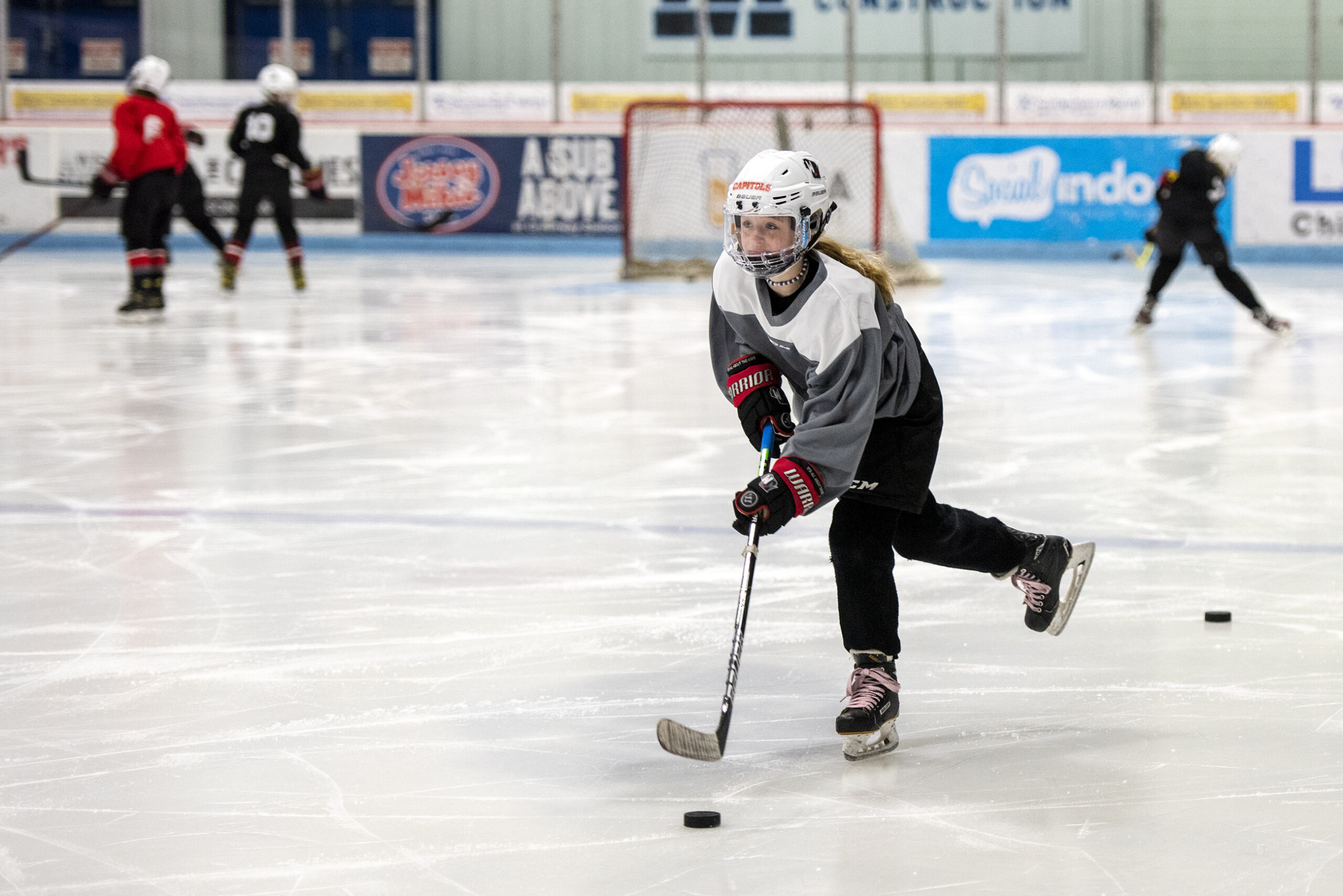
This is something Robin Bilsborough sees all the time. She’s the region five director and girls’ and women’s section director for the Wisconsin Amateur Hockey Association, or WAHA. She got involved with the organization when her own kids started playing hockey, and she noticed her sons and daughters had totally different experiences.
According to Bilsborough, boys make up about 80 percent of WAHA players across the state. With more teams, boys had more opportunities to play and compete compared to girls. When teams did fun activities like sleepovers, the one or two girls on the team were always left out.
“Part of youth sports is that team environment,” Bilsborough said. “It’s not just all about being a great athlete. It’s all about the connections and the team camaraderie. And that was lacking.”
Bilsborough noticed that without a strong connection early on, girls tended to drop out around age 10. To attract and retain new players, she decided to focus on strengthening the experience for the youngest players. So, she started the region’s first all-girls team for kids 8 years old and younger. And it worked.
When she started, girls made up only 13 percent of the players in her region. Five years later, that number has grown to 33 percent, surpassing the statewide average. Other regions are starting to take notice and follow her lead.
“The biggest thing is to actually provide a team,” Bilsborough said. “Bringing girls in at the bottom ages, it provided that entrance level so girls could join hockey and then continue to play hockey as they aged up.”
For many parents, the physicality of hockey is a deterrent when it comes to putting girls on boys teams. But in girls and women’s hockey, there is no checking. Many argue this not only makes the game safer, but has made the women’s game better. Without checking, players are forced to rely more on skating and puck-handling skills. Kendall Coyne Schofield’s lightning-fast lap around the rink at the 2019 NHL All-Stars event is case in point.
But the real impact of an all-girls team isn’t just on the ice, it’s in the locker room.
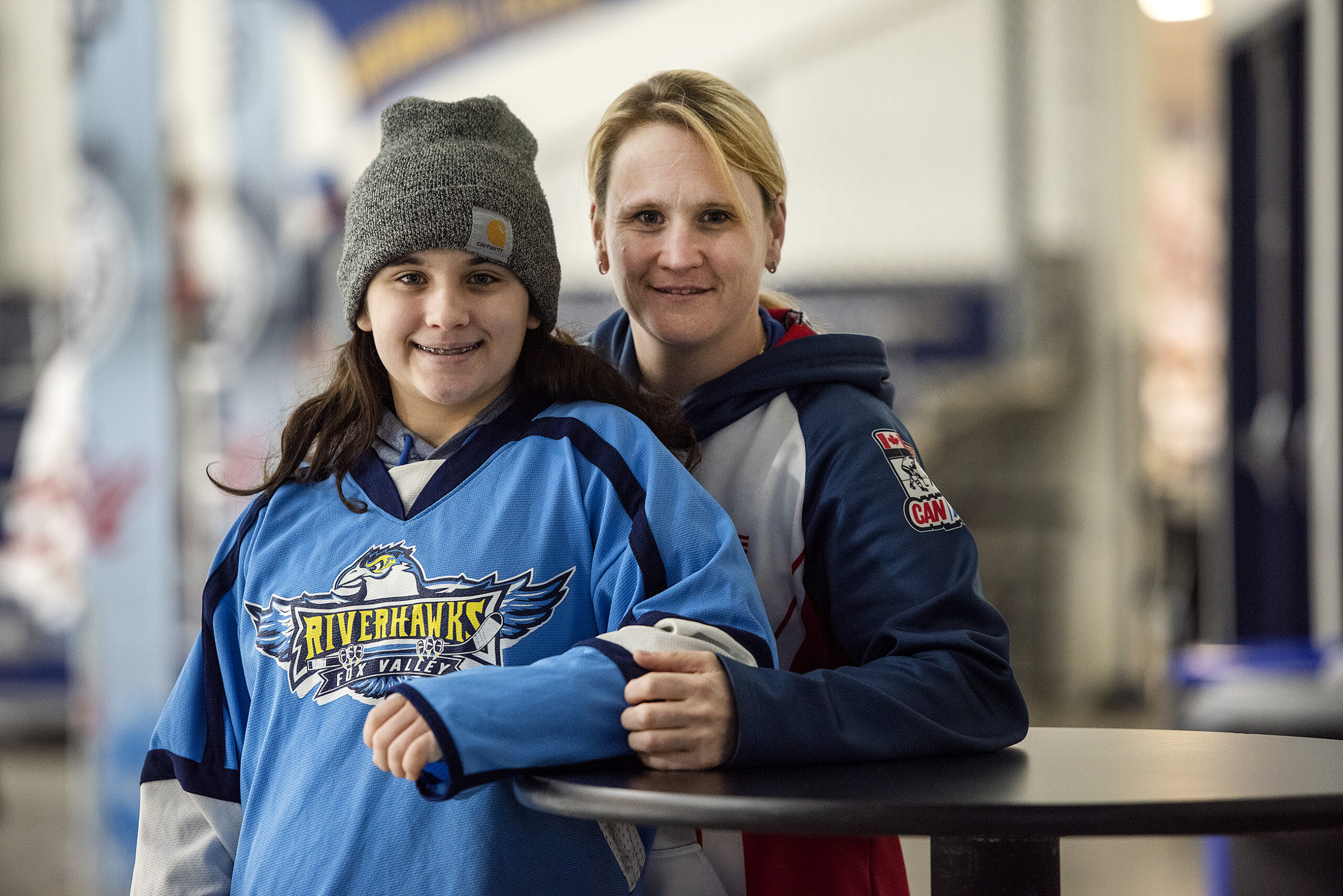
Jessie DeMarasse, 13, fell in love with hockey watching her mom play in a men’s league. She was so excited to get her first pair of skates that she wore them around the house, pretending to skate wherever she went. But when she signed up to play, the only option near her home in Milton was a boys team.
“One time, I had to change in a closet with two other girls,” DeMarasse said.
Now she plays goalie for the Madison Mavericks 14U girls team in Verona, which is at least a 45-minute drive. But DeMarasse said she feels more included.
Amanda Ferwerda understands why.
“You’re in a team sport, and it’s about being with the team, building that camaraderie, building those relationships and getting yourself set and comfortable for the game. You can’t do that in a small closet getting ready by yourself,” she said.
Amanda Ferwerda’s 7-year-old daughter, Samantha, also plays hockey on a boys team. But she said if there were a girls team available, she wouldn’t hesitate to sign her daughter up for it.
“I know what kind of relationships that I’ve forged with my teammates over the years. I still talk to them to this day. And I know that that’s what you get playing on an all-girls team. Representation matters and being with people that are like you matters,” she added.
[[{“fid”:”1665041″,”view_mode”:”full_width”,”fields”:{“format”:”full_width”,”alignment”:”center”,”field_image_caption[und][0][value]”:”%3Cp%3ENora%20Martin%20and%20her%20teammates%20listen%20to%20a%20coach%20during%20practice%20Saturday%2C%20Feb.%2012%2C%202022%2C%20at%20Bob%20Suter%E2%80%99s%20Capitol%20Ice%20Arena%20in%20Middleton%2C%20Wis.%20%3Cem%3EAngela%20Major%2FWPR%3C%2Fem%3E%3C%2Fp%3E%0A”,”field_image_caption[und][0][format]”:”full_html”,”field_file_image_alt_text[und][0][value]”:”A group of youth hockey players kneel on the ice as a coach speaks to them. “,”field_file_image_title_text[und][0][value]”:”Girls Hockey”},”type”:”media”,”field_deltas”:{“5”:{“format”:”full_width”,”alignment”:”center”,”field_image_caption[und][0][value]”:”%3Cp%3ENora%20Martin%20and%20her%20teammates%20listen%20to%20a%20coach%20during%20practice%20Saturday%2C%20Feb.%2012%2C%202022%2C%20at%20Bob%20Suter%E2%80%99s%20Capitol%20Ice%20Arena%20in%20Middleton%2C%20Wis.%20%3Cem%3EAngela%20Major%2FWPR%3C%2Fem%3E%3C%2Fp%3E%0A”,”field_image_caption[und][0][format]”:”full_html”,”field_file_image_alt_text[und][0][value]”:”A group of youth hockey players kneel on the ice as a coach speaks to them. “,”field_file_image_title_text[und][0][value]”:”Girls Hockey”}},”link_text”:false,”attributes”:{“alt”:”A group of youth hockey players kneel on the ice as a coach speaks to them. “,”title”:”Girls Hockey”,”class”:”media-element file-full-width media-wysiwyg-align-center”,”data-delta”:”5″}}]]
Passing the puck to the next generation
When Brianna Decker was injured during Team USA’s first game against Finland, she expressed gratitude for all the support, referring to her teammates as her sisters. And that sisterhood extends across generations.
In 2018, the two-time Olympian and former UW-Madison Badger started an endowment to support 8U and 10U girls hockey teams in Wisconsin, hoping to get younger girls into the game. With the same goal in mind, Granato recently published a children’s book about her own experiences playing boys hockey.
“This is why these young girls nowadays are so lucky, because you’ve got this type of person that went through the system and wants to get it better for you, giving back,” said Mary Ann Robinson, a former WAHA and USA Hockey director and longtime advocate for girls hockey.
And the consistent success of women’s teams like Wisconsin, Team USA and Team Canada — despite lingering inequities in the sport — is inspiration in itself.
“It’s amazing to see them be able to play and know that they had to go through stuff to get to where they are right now,” Nora Martin said. “To see that they’re in the Olympics, to see that they’re on TV, just to see that they’re playing is, like, amazing to watch.”
Her favorite player is Decker.
“She’s aggressive, she’s strong and she has a passion for hockey,” she said.
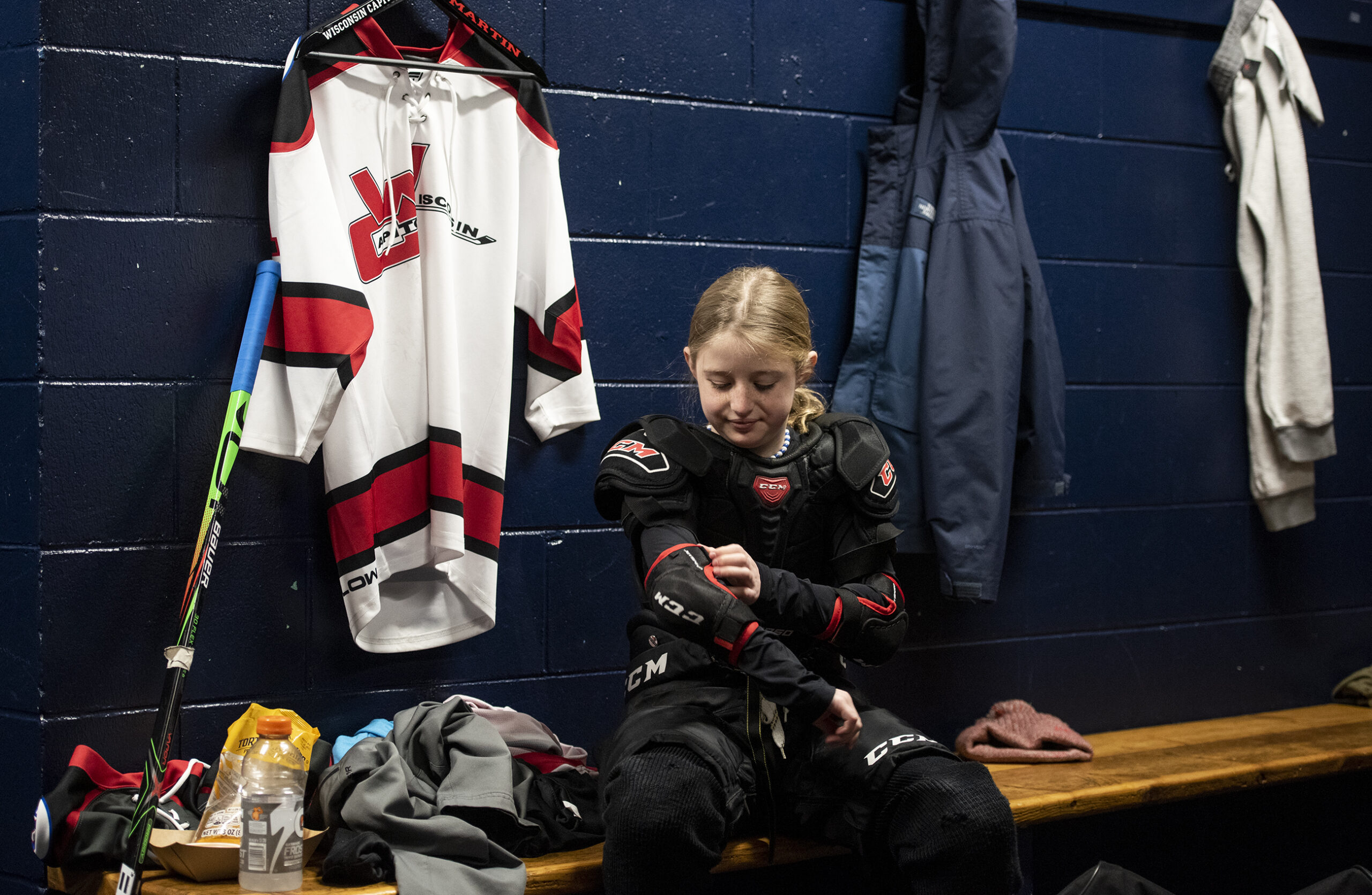
Wisconsin Public Radio, © Copyright 2025, Board of Regents of the University of Wisconsin System and Wisconsin Educational Communications Board.
